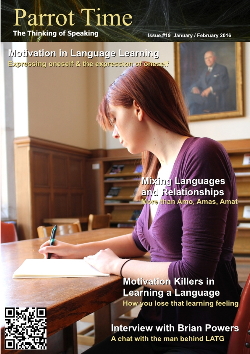
|
Of all the possible ways to learn a language, the internet seems to be the one with the most varied possibilities. It can mix the elements of other methods, potentially being the second most effective means of language acquistion. I say "second" because no method of learning can possibly be better than old fashioned immersion, in which a person is constantly completely surrounded by the language. That is the method which everyone uses to learn their own native language. I say "potentially" because one has to find not only a good mix of materials and applications, but they must also find the ones that work for them. Everyone has ways they find useful and others that they don't. Web sites on the internet vary greatly on what they have to offer, and that is what we are going to look at in this article. Digital Books The most basic way a site can help is to provide the learner with written material. Textbooks and phrasebooks can be presented in a digital form, just like their written forms. The user can page through the material to read on the screen, or they can print it out to be read offline, like normal printed material. In fact, a web site can do almost everything software can do. Drills and games, interactive readings, audio and visual... if there is a program that does it, most likely it can reproduced on a web site. So why would someone look on the internet for this, when they could just buy a book? Well, for one thing, there is plenty of free materials out there, professionally created or produced by other language lovers. The Foreign Service Institute, a division of the United States government, created many courses for use in the military, and these are freely available to anyone online. Older books that are no longer under copyright can also be found for many languages, and these range from informational to grammars to dictionaries. Another useful aspect of these digital versions is that a person can print out just the parts they want at a particular time. With a normal textbook, the entire book has to be carried around, while printed copies of the online forms can be tailored to exactly what a person is learning at that moment. With the increasing number of portable devices, like phones, tablets and electronic book readers, the digital copies can also be taken everywhere without being printed. It's possible to carry a few dozen textbooks around on a device that fits in your shirt pocket! Flashcards Originally, flashcards came in thick decks of cardboard. They are now a very popular method of vocabulary acquisition in the form of digital packs that can be handled using a piece of software. The internet can expand that even further by giving people a chance to share their decks with others, completely free. There are a number of sites with huge repositories of these decks in many languages, just waiting to be downloaded or used online. A program can handle all the grading and tracking as well. Many can present you the cards in a variety of formats, including multiple choice and fill-in. Images and sounds can even be included, to better help with the memorization and understanding.  Soldier using non-digital cards to teach children in Iraq Interaction A flashcard deck is just a list of vocabulary words, and computers can do a lot more with that. The interactive nature of computers allows those same lists to be used in various other forms of drills and games. Hangman, Memory, Matching, Word Search and Word Scramble are all interactive games that one can play online, and there are several sites that offer these. But surely, that can be done with any computer. One doesn't need a website for that. A website, however, can make it easier to find the different language pairs one might desire. It can also be used any on various digital devices without requiring a download. For example, you might have a great word search game on your laptop, but there isn't a version available for your phone. If both of those devices can access a web site which has that game, the problem is solved.  Phone being used to talk to someone in another language The real beauty of having this online, however, is that you can actually play these games against another person. The original game of Memory uses a deck of cards full of pairs of items to find. These cards are placed face down on a surface and the players take turns turning over two cards at a time, hoping to find a match. If the two cards don't match, they are turned face down again and it is the next person's turn. Playing this game on a computer normally involves either the computer acting as the other player, or the user simply keeps selecting cards. This process might be enhanced by using having a time limit to find all the cards, but in either case, it is far less competitive than playing against another human. Having the game on a site allows for the possibility of playing against another player in real time. The two (or more) people take turns playing as they would normally, with the computer taking the place of the cards. The players don't have to be in the same room or even the same country. And this can be done with a number of games. In some versions, the players don't even have to be studying the same languages. For example, a version of the board game Battleship might require a player to successfully answer a vocabulary question in order to achieve a hit. In this way, one person might be practicing Italian while the other learns Japanese, because each of them is getting the questions for their specific language. This can be taken even further, in terms of globalization. One player might be a German studying Italian, so his view of the game is in German and the questions are for Italian, while the other player might be an Indian learning Japanese, with her interface in Hindi. The web site can be programmed for any of that. In fact, a web site can do almost everything software can do. Drills and games, interactive readings, audio and visual... if there is a program that does it, most likely it can reproduced on a web site. A perfect example of this is LiveMocha. The basic core of this language learning site is lessons in which words and phrases are taught using images, with no native language involved. This method is taken directly from the very popular (and very expensive) software package Rosetta Stone. LiveMocha has expanded its site to include many other methods of learning which utilize the internet, like the ones we will look at shortly. These two companies are so similar that Rosetta Stone bought the LiveMocha company and web site in order to expand its user base. Globalization The internet is available in almost every country. This opens up so many more possibilities for language learning. People in distant countries can talk to each other instantly. Normal learning methods that interact with others is limited to those immediately around oneself. Someone might be taking a course in German, but they become greatly limited in their growth by access to native or fluent speakers. On the internet, however, they can talk to Germans in Germany and really improve their fluency. This talking can be in many forms as well. They might exchange emails or send messages on a site. They might post to a larger group using a particular forum. For talking in real time, they could use a chat program and exchange messages instantly. One of the most popular means of doing that is the Internet Relay Chat, or IRC. Even more advanced methods exist for chatting, using voice and video through programs like TeamSpeak and Skype. All of these are completely free for use. Suddenly, the world is a whole lot smaller. The key part to using web sites is that they can truly be designed for just about anything. One very popular kind of site utilizes just the basics for aiding in the chatting. Language exchanges are similar to the old fashioned "penpals" that were used with written mail. A person enrolls in a program in order to find another person for the purpose of exchanging information. This was a method of helping children learn about other cultures, for they would get a penpal with another child in a different country. The language exchange does similar by helping people to team up with others learning a language. The slight twist on this is that the users cross match their interests. The German learning Italian would want to find an Italian learning German, so that they can help each other in their target languages. A site that performs this function might be nothing more than a list of searchable profiles. They might include a few resources to aid in the people communicating online, like text or voice chat, or simply provide each other's email addresses. Some sites might even provide a very structured framework for the exchange, like limiting the time spent on each language, so that one person doesn't dominate the exchange. Language Feedback  Woman using a headset to talk to somone over the internet Lets say that our fictional German is practising writing Italian, but he is too nervous to attempt direct conversation. Or perhaps he wants to practise writing beyond what is said in normal conversations. A web site might have a writing area for this. The German could write about any topic and have it posted for others, preferably Italian natives or those fluent in Italian, reviewing it. They could then post responses to the writing, making corrections and giving explanations. This method of learning through feedback has become popular on a number of sites, most notably Lang-8, a Japanese based site, in which members constantly help each other improve their writing skills in other languages. But computers are more than just textual mediums. They can also provide audio and video, and some sites also take advantage of that. The writing practice system could also be done for audio, with people recording themselves reading texts and posting those for review. Responders could then possibly post text or their own recordings to aid the learner. Both of these setups allow for groups to help each other. It also provides a global classroom format without a teacher, with each person learning at their own pace while getting personalized attention. |
| Language Learning Methods - Internet | |||||||
| Writer: | Erik Zidowecki | ||||||
| Images: | |||||||
| |||||||
All images are Copyright - CC BY-SA (Creative Commons Share Alike) by their respective owners, except for Petey, which is Public Domain (PD) or unless otherwise noted.
comments powered by Disqus



















